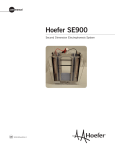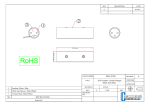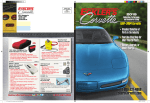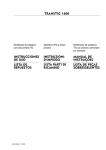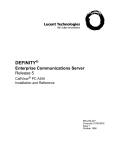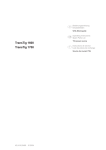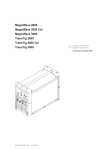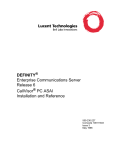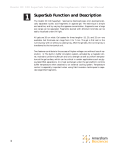Download SUB Series Horizontal Electrophoresis Units
Transcript
user manual SUB Series Horizontal Electrophoresis Units SUB6, SUB10, SUB13, SUB15, SUB20, SUB25, SUB20C, SUB25C and SUBHT um SUB-IM/Rev.C0/07-12 Page Finder Important Information.............................................ii Waste Electrical & Electronic Equipment (WEEE)..... ix Specifications....................................................... 1 Safety Precautions................................................. 2 General Care and Maintenance............................... 3 Gel Loading Instructions for the SUBHT.................. 5 Cleaning and Storage............................................. 6 Packing Lists........................................................ 7 Operational........................................................... 9 SUB6 Mini Horizontal....................................... 9 SUB10 Mini-Plus Horizontal .......................... 10 SUB13 Midi Horizontal................................... 11 SUB15 Standard Horizontal............................ 12 SUB20 Maxi-Standard Horizontal.................... 13 SUB25 Maxi-Plus Standard Horizontal............. 14 SUB20C Maxi-Cooled Horizontal...................... 15 SUB25C Maxi-Plus Cooled Horizontal.............. 16 SUBHT High Throughput Horizontal................. 17 Using The Horizontal Gel Electrophoresis Units...... 18 Preparation of Agarose Gels............................. 18 Agarose Gel Electrophoresis............................. 19 Gel Pouring.................................................... 20 Running the Gel............................................. 22 • pi Important Information – English • If this equipment is used in a manner not specified by Hoefer, Inc. the protection provided by the equipment may be impaired. • This instrument is designed for indoor laboratory use only. • Only accessories and parts approved or supplied by Hoefer, Inc. may be used for operating, maintaining, and servicing this product. • Rozeslat pouze voda nebo 50/50 voda/ ethylenglykolu prostřednictvím výměník tepla je li to vybavena. Nemají připojení výměník tepla s vodními setřepná nebo jakékoli chladicí kapaliny zdroje, kde tlak vody je neregulo. • Nikdy zavést prostředek proti zamrznutí nebo jakákoli organická rozpouštědla do jakékoli části z tohoto nástroje. Rozpustidlům způsobí nenapravitelné poškození jednotka! • Only use a power supply that is CE marked or safety certified by a nationally recognized testing laboratory. • Nejsou provozována s pufru teplotách nad maximální stanovenou technickými specifikacemi. Přehřátí způsobí nenapravitelné poškození jednotka! • The safety lid must be in place before connecting the power supply leads to a power supply. Vigtig Information – Danish • Turn all power supply controls off and disconnect the power leads before removing the safety lid. • Circulate only water or 50/50 water/ethylene glycol through the heat exchanger if so equipped. Do not connect the heat exchanger to a water tap or any coolant source where the water pressure is unregulated. • Never introduce antifreeze or any organic solvent into any part of the instrument. Organic solvents will cause irreparable damage to the unit! • Do not operate with buffer temperatures above the maximum specified technical specifications. Overheating will cause irreparable damage to the unit! Duležité Informace – Czech • Pokud by toto zařízení je použito způsobem, který není podle Hoefer, Inc. ochrana poskytovaná na základě zařízení může být narušena. • Tento nástroj je určen pro vnitřní použití v laboratoři pouze. • Pouze příslušenství a části schválen, nebo poskytnutých Hoefer, Inc. mohou být použity pro provoz, údržbu, a údržbě tohoto výrobku. • zdroj napájení používají jen že je opatřen označením CE osvědčena nebo bezpečnost vnitrostátně uznanými zkušebními laboratoř. • Bezpečnosti lid musí být zavedena před připojením napájecí zdroj napájení vede k. • Turn veškeré napájení kontroly vypnuto a odpojit před odběrem energie vede bezpečnostní víko. • pii • Hvis dette udstyr bruges i en måde ikke specificeret ved Hoefer, Inc. den beskyttelse, som er blevet forsynet af udstyret kan måske svækkes. • Dette instrument er designet for indendørs laboratoriumbrug bare. • Bare tilbehør og del godkendede eller forsynede ved Hoefer, Inc. kan måske bruges for drive, funktionsfejl, og betjening dette produkt. • bruger Bare en strømforsyning, der er CE markerede eller sikkerhed, som er blevet attesteret af en, som nationalt er blevet anerkendt prøve laboratorium. • Sikkerhedlåget må være på plads før forbinding strømforsyningsblyet til en strømforsyning. • Drejer alle strømforsyningskontroller af og afbryder kraftblyet før fjerning sikkerhedlåget. • Cirkulerer bare vand eller 50/50 vand/ethylene glykol gennem varmeveksleren i så fald udrustet. Forbind ikke varmeveksleren til en vandhane eller nogen kølemiddelkilde hvor vandtrykket er unregulated. • Introducerer Aldrig antifreeze eller noget organisk opløsningsmiddel ind i nogen del af instrumentet. Organiske opløsningsmidler vil forårsage uboelig skade til enheden! • Driver ikke med stødpudetemperaturer over maksimummet specificerede tekniske specifications. Overheding vil forårsage uboelig skade til enheden! Belangrijke Informatie – Dutch • Indien deze uitrusting in een manier wordt gebruikt die niet door Hoefer, Inc. is gespecificeerd de bescherming die door de uitrusting is verzorgd kan worden geschaad. • Dit instrument is voor binnenlaboratoriumgebruik enkel ontworpen. • Enkel onderdelen en delen keurden goed of leverden door Hoefer, Inc. kan voor het bedienen worden gebruikt, handhavend en onderhouden van dit product. • gebruik Enkel een netvoeding die CE is markeerde of veiligheid die door een is gecertificeerd die nationaal is herkend testene laboratorium. • Het veiligheidsdeksel moet in plaats voor het verbinden van de netvoeding leidt tot een netvoeding zijn. • Doe alle netvoedingscontroles Uit en koppel los de machtleiding voor het verwijderen van het veiligheidsdeksel. • Circuleer enkel water of 50/50 water/ ethyleenglycol door de hitte exchanger zo ja uitrust. Verbind de hitte exchanger naar een waterkraan of koelmiddelbron niet waar de waterdruk niet geregulariseerd is. • Stel Nooit antivriesmiddel of organische oplosmiddelen in deel van het instrument voor. Organische oplosmiddelen zullen onherstelbare schade aan de eenheid veroorzaken! • Bedien niet met buffertemperaturen boven het maximum specificeerde technische specificaties. Oververhittend zal onherstelbare schade aan de eenheid veroorzaken! joka on kansallisesti tunnustettnut testaaminen laboratoriota. • Turvallisuuskansi täytyy olla paikallaan ennen yhdistäminen käyttöjännitelyijyjä käyttöjännitteeseen. • Kiertää kaikki käyttöjännitevalvonnat ja irrottaa valtalyijyt ennen poistaminen turvallisuuskantta. • Kiertää vain vesi tai 50/50 vesi/ethyleneä glycol siinä tapauksessa varustetun lämmönvaihtimen läpi. Älä yhdistä lämmönvaihdinta vesinapautukseen eikä jäähdytysnestelähteeseen, missä vesipaine on unregulated. • Pakkasneste eikä orgaaninen liuotin välineen osassa ei esitele Koskaan. Orgaaniset liuottimet aiheuttavat korvaamattoman vahingon yksikköön! • Ei käytä puskuria yllä olevia lämpötiloja enintään määritetyillä teknisillä täsmennyksillä. Ylikuumeneminen aiheuttaa korvaamattoman vahingon yksikköön! Information Importante – French • Si cet équipement est utilisé dans une manière pas spécifié par Hoefer, Inc. la protection fourni par l’équipement pourrait être diminuée. • Cet instrument est conçu pour l’usage de laboratoire intérieur seulement. • Seulement les accessoires et les parties ont approuvé ou ont fourni par Hoefer, Inc. pourrait être utilisé pour fonctionner, maintenir, et entretenir ce produit. • utilise Seulement une alimentation qui est CET a marqué ou la sécurité certifié par un nationalement reconnu essayant le laboratoire. Tärkeää Tietoa – Finnish • Le couvercle de sécurité doit être à sa place avant connecter l’alimentation mene à une alimentation. • Jos tätä varusteita käytetään tavassa ei määritetty Hoefer, Inc. suojelu ehkäisty varusteille saattaa olla avuton. • Tourner tous contrôles d’alimentation de et débrancher les avances de pouvoir avant enlever le couvercle de sécurité. • Tämä väline suunnitellaan sisälaboratoriokäytölle vain. • Circuler seulement de l’eau ou 50/50 glycol d’eau/ éthylène par l’exchanger de chaleur si si équipé. Ne pas connecter l’exchanger de chaleur à un robinet d’eau ou à la source d’agent de refroidissement où la pression d’eau est non régulée. • Vain lisävarusteet ja osat hyväksyivät tai toimitti Hoefer, Inc. oheen ää voi käyttää käyttämiselle, valvoalle, ja servicing tämä tuote. • Vain käyttää käyttöjännitettä joka on CE merkitsi tai turvallisuus joka on todistanut aidoksi ohi • Ne Jamais introduire d’antigel ou du dissolvant organique dans n’importe quelle partie de • piii l’instrument. Les dissolvants organiques causeront des dommages irréparables à l’unité! • Ne pas fonctionner avec les températures de tampon au-dessus du maximum a spécifié des spécifications techniques. La surchauffe causera des dommages irréparables à l’unité ! Wichtige Informationen – German • Wenn diese Ausrüstung gewissermaßen nicht angegeben durch Hoefer, Inc. verwendet wird, kann der durch die Ausrüstung zur Verfügung gestellte Schutz verschlechtert werden. • Dieses Instrument wird für den Innenlaborgebrauch nur dafür entworfen. • Nur Zusätze und Teile genehmigten oder lieferten durch Hoefer, Inc. kann für das Funktionieren, das Aufrechterhalten, und die Wartung dieses Produktes verwendet werden. • Verwenden Sie nur eine Energieversorgung, die CE gekennzeichnet oder durch ein national anerkanntes Probelaboratorium bescheinigte Sicherheit ist. • Der Sicherheitsdeckel muss im Platz vor dem Anschließen der Energieversorgung sein führt zu einer Energieversorgung. • Alle Energieversorgungssteuerungen abdrehen und die Macht trennen führt vor dem Entfernen des Sicherheitsdeckels. • Nur Wasser oder 50/50 Glykol des Wassers/ Äthylens durch den Wärmeaustauscher, wenn so ausgestattet, in Umlauf setzen. Verbinden Sie den Wärmeaustauscher mit einem Wasserklaps oder jeder Kühlmittel-Quelle nicht, wo der Wasserdruck ungeregelt wird. • Führen Sie nie Frostschutzmittel oder jedes organische Lösungsmittel in jeden Teil des Instrumentes ein. Organische Lösungsmittel werden nicht wiedergutzumachenden Schaden der Einheit verursachen! • Mit Puffertemperaturen über angegebenen technischen Spezifizierungen des Maximums nicht funktionieren. Die Überhitzung wird nicht wiedergutzumachenden Schaden der Einheit verursachen! Informazioni Importanti – Italian • Se quest’apparecchiatura è usata in un modo specificato da Hoefer, Inc. la protezione fornito dall’apparecchiatura potrebbe essere indebolita. • Questo strumento è disegnato per l’uso di laboratorio interno solo. • Solo gli accessori e le parti hanno approvato o hanno fornito da Hoefer, Inc. potrebbe essere usato per operare, per mantenere, e per revisionare questo prodotto. • usa Solo un alimentatore che è CE ha marcato o la sicurezza certificato da un nazionalmente riconosciuto testando il laboratorio. • Il coperchio di sicurezza deve essere nel luogo prima di collegare i piombi di alimentatore a un alimentatore. • Spegne tutto i controlli di alimentatore e disinserisce i piombi di potere prima di togliere il coperchio di sicurezza. • Circola solo l’acqua o 50/50 glicole di acqua/ etilene attraverso lo scambiatore di calore se così equipaggiato. Non collegare lo scambiatore di calore a un rubinetto di acqua o qualunque fonte di refrigerante dove la pressione di acqua è sregolata. • Non introduce mai l’antigelo o qualunque solvente organico in qualunque parte dello strumento. I solventi organici causeranno il danno irreparabile all’unità! • Non opera con le temperature di tampone al di sopra del massimo ha specificato le descrizioni tecniche. Il surriscaldamento causerà il danno irreparabile all’unità! Viktig Informasjon – Norwegian • Hvis dette utstyret blir brukt i en måte ikke spesifisert ved Hoefer, Inc. beskyttelsen som ha blitt git av utstyret kan bli svekket. • Dette instrumentet er utformet for innendørs laboratoriumbruk bare. • Bare tilbehør og deler godkjente eller forsynte ved Hoefer, Inc. kan bli brukt for drive, vedlikeholde, og betjene dette produktet. • bruker Bare en kraftforsyning som er CE merket eller sikkerhet som ha blitt sertifisert av et som • piv nasjonalt ha blitt anerkjent prøver laboratorium. • Sikkerheten lokket må være på plass før forbinding kraftforsyningene blyene til en kraftforsyning. • Vender all kraftforsyningsstyring av og frakopler kreftene blyene før fjerning sikkerheten lokket. • Sirkulerer bare vann eller 50/50 vann/ethylene glykol gjennom oppvarmingen veksleren i så fall utstyrer. Ikke forbind oppvarmingen veksleren til en vanntapp eller noe kjølemiddelkilde hvor vannet trykket er unregulated. • Introduserer Aldri antifreeze eller noe organisk løsemiddel inn i noe del av instrumentet. Organiske løsemiddler vil forårsake irreparabel skade på enheten ! • Driver med buffertemperaturer over maksimum ikke spesifiserte teknisk spesifikasjoner. Å overoppheting vil forårsake irreparabel skade på enheten ! Wazne Informacje – Polish • Jeżeli ten sprzęt jest wykorzystywany w sposób nie określone przez Hoefer, Inc. do ochrony przewidzianej przez urządzenie może zostać obniżony. • Instrument ten jest przeznaczony do użytku w laboratoriach kryty tylko. • Tylko akcesoriów i części zatwierdzone lub dostarczone przez Hoefer, Inc. mogą być wykorzystane do eksploatacji, utrzymania i obsługi tego produktu. • korzystać jedynie zasilacza że jest noszące oznakowanie CE lub bezpieczeństwa uwierzytelnione przez uznane na poziomie krajowym laboratorium badawcze. • Bezpieczeństwo lid musi być w miejsce przed podłączeniem zasilania prowadzi do zasilania. • Zaś wszystkie źródła zasilania urządzenia sterujące off i odłączyć moc prowadzi przed odbiorem bezpieczeństwa lid. • Krążą tylko wody lub wody 50/50/ethylene glycol wymiennik ciepła poprzez jeśli tak wyposażone. Nie należy połączyć wymiennik ciepła woda z kranu lub jakimkolwiek chłodziwo źródła, jeżeli ciśnienie wody jest nieuregulowanych. • Nigdy nie wprowadzać rozpuszczalnika organicznego przeciw zamarzaniu lub jakichkolwiek na dowolną część dokumentu. Rozpuszczalniki organiczne spowoduje nieodwracalne szkody dla jednostki! • Nie działają w buforze temperatury powyżej maksymalnego określone specyfikacje techniczne. Przegrzania spowoduje nieodwracalne szkody dla jednostki! Informações Importantes – Portuguese • Se este equipamento é usado numa maneira não especificada por Hoefer, Inc. que a protecção fornecida pelo equipamento pode ser comprometida. • Este instrumento é projectado para uso de interior de laboratório só. • Só acessórios e partes aprovaram ou forneceu por Hoefer, Inc. pode ser usada para operar, manter, e servicing este produto. • Só usa um estoque de poder que é CE marcou ou segurança registrada por um nacionalmente reconhecido testando laboratório. • A tampa de segurança deve estar em lugar antes de ligar o estoque de poder leva a um estoque de poder. • Desliga todos controlos de estoque de poder e desconecta os chumbos de poder antes de retirar a tampa de segurança. • Circulam só água ou 50/50 glicol de água/ethylene pelo exchanger de calor se for assim equiparam. Não ligue o exchanger de calor a uma torneira de água nem qualquer fonte de refrigerante onde a pressão de água é não regulado. • Nunca introduz anticongelante nem qualquer orgânico solvente em qualquer parte do instrumento. Orgânico solvente causará agressão irreparável à unidade! • Não opera com temperaturas de buffer acima do máximo especificou especificações técnicas. Superaquecer causará agressão irreparável à unidade! • pv Información Importante – Spanish • Si este equipo es utilizado en una manera no especificado por Hoefer, Inc. la protección proporcionado por el equipo puede ser dañada. • Este instrumento es diseñado para el uso interior del laboratorio sólo. • Sólo accesorios y partes aprobaron o suministraron por Hoefer, Inc. puede ser utilizado para operar, para mantener, y para atender a este producto. • Sólo utiliza una alimentación que es CE marcó o la seguridad certificada por un nacionalmente reconocido probando el laboratorio. • La tapa de la seguridad debe estar en el lugar antes de conectar la alimentación lleva a una alimentación. • Apaga todos controles de alimentación y desconecta los plomos del poder antes de quitar la tapa de la seguridad. • Circula sólo agua o 50/50 glicol de agua/etileno por el intercambiador de calor si ése es el caso equiparon. No conecte el intercambiador de calor a un toque de la agua ni cualquier fuente del líquido refrigerante donde la presión del agua está libre. • Nunca introduce anticongelante ni algún solvente orgánico en cualquier parte del instrumento. Los solventes orgánicos causarán daño irreparable a la unidad! • No opera con temperaturas de búfer encima del máximo especificó especificaciones técnicas. Recalentar causará daño irreparable a la unidad! Viktig Information – Swedish • om denna utrustning används i ett sätt som inte har specificeras av Hoefer, Inc. skyddet tillhandahöll vid utrustningen kan skadas. • Detta instrument formges för inomhuslaboratorium användning bara. • Bara medhjälpare och delar godkände eller levererade vid Hoefer, Inc. kan användas för fungera, underhålla, och servicing denna produkt. • använder bara en kraft tillgång som är CE markerade eller säkerhet intygade vid en nationellt erkänd testande laboratorium. • pvi • Säkerheten locket måste vara på platsen före koppla kraften tillgången blyen till en kraft tillgång. • Vänder sig alla kraft tillgång kontroller av och kopplar bort kraften blyen före flytta säkerheten locket. • Cirkulerar bara vatten eller 50/50 vatten/ethylene glycol genom värmen exchanger i så utrustad fall. Inte kopplar värmen exchanger till en vatten kran eller något kylmedel källa där vattnet trycket är unregulated. • Inför aldrig kylvätska eller något organiska lösningsmedel in i någon del av instrumentet. Organiskt lösningsmedel ska orsaka irreparable skada till enheten! • Använd inte med buffert temperaturer över det högsta angivna tekniska specifikationerna. Överhettning skulle orsaka irreparabla skador på enheten! Waste Electrical and Electronic Equipment (WEEE) English This symbol indicates that the waste of electrical and electronic equipment must not be disposed as unsorted municipal waste and must be collected separately. Please contact an authorized representative of the manufacturer for information concerning the decommissioning of your equipment. French Ce symbole indique que les déchets relatifs à l’équipement électrique et électronique ne doivent pas être jetés comme les ordures ménagères non-triées et doivent être collectés séparément. Contactez un représentant agréé du fabricant pour obtenir des informations sur la mise au rebut de votre équipement. German Dieses Symbol kennzeichnet elektrische und elektronische Geräte, die nicht mit dem gewöhnlichen, unsortierten Hausmüll entsorgt werden dürfen, sondern separat behandelt werden müssen. Bitte nehmen Sie Kontakt mit einem autorisierten Beauftragten des Herstellers auf, um Informationen hinsichtlich der Entsorgung Ihres Gerätes zu erhalten. Italian Questo simbolo indica che i rifiuti derivanti da apparecchiature elettriche ed elettroniche non devono essere smaltiti come rifiuti municipali indifferenziati e devono invece essere raccolti separatamente. Per informazioni relative alle modalità di smantellamento delle apparecchiature fuori uso, contattare un rappresentante autorizzato del fabbricante. Spanish Este símbolo indica que el equipo eléctrico y electrónico no debe tirarse con los desechos domésticos y debe tratarse por separado. Contacte con el representante local del fabricante para obtener más información sobre la forma de desechar el equipo. Swedish Denna symbol anger att elektriska och elektroniska utrustningar inte får avyttras som osorterat hushållsavfall och måste samlas in separat. Var god kontakta en auktoriserad tillverkarrepresentant för information angående avyttring av utrustningen. • pvii Specifications Application For laboratory use only in the electrophoretic separation of proteins and nucleic acids. Country of Origin: United States Manufacturer: Hoefer, Inc. 84 October Hill Road Holliston, MA 01746 Toll Free: 1-800-227-4750 Phone: 1-508-893-8999 Fax: 1-508-429-5732 E-mail: [email protected] Construction • • • • ugged acrylic construction. R All acrylic joints chemically bonded. Doubly insulated cables, rated safe up to 1,000 V. Gold plated electrical connectors, corrosion-free and rated safe up to 1,000 V. • Recessed power connectors, integral with the safety lid. • 0.2 mm diameter platinum electrodes, 99.99% pure. • User replaceable platinum electrodes. • User-friendly clamping system. • Wide range of accessories. Environmental Conditions •T his apparatus is intended for indoor use only. • This apparatus can be operated safely up to an altitude of 2,000 m. • The normal operating temperature range is between 4 °C and 65 °C. • Maximum relative humidity 80% for temperatures up to 31 °C decreasing linearly to 50% relative humidity at 40 °C. • The apparatus is rated POLLUTION DEGREE 2 in accordance with IEC 664. POLLUTION DEGREE 2, states that: “Normally only non-conductive pollution occurs. Occasionally, however, a temporary conductivity caused by condensation must be expected”. • p1 Safety Precautions • READ the instructions before using the apparatus. •T he exclamation mark within an equilateral triangle is intended to alert the user to the presence of important operating and maintenance instructions in the literature accompanying the instrument. •A lways unplug electrophoresis units from their power supply before removing the safety cover. Unplug the power supply from the mains FIRST, then disconnect the leads. •D O NOT exceed the maximum operating voltage or current. •D O NOT operate the electrophoresis units in metal trays. • It is advisable to always place the unit on a plastic safety tray during electrophoresis. •E thidium bromide is a known mutagen. Wear effective protective clothing when handling and follow recommended handling and disposal procedures. •U ltraviolet light can cause permanent damage to the retina and skin cancer. Wear UV safety goggles and cover any exposed skin when using a UV light source. •F ollowing the replacement of a platinum electrode, have the unit inspected and approved by your safety officer prior to use. •D O NOT fill the unit with running buffer above the maximum fill lines. • DO NOT move the unit when it is running. • CAUTION: During electrophoresis, very low quantities of various gases are produced at the electrodes. The type of gas produced depends on the composition of the buffer employed. To disperse these gases make sure that the apparatus is run in a well ventilated area. • p2 General Care and Maintenance •T o remove the safety lid, push thumbs down on the plastic lugs and lift the lid vertically with your fingers. •B efore use, clean and dry the apparatus with DISTILLED WATER ONLY. IMPORTANT! Acrylic plastic is NOT resistant to aromatic or halogenated hydrocarbons, ketones, esters, alcohol’s (over 25%) and acids (over 25%), they will cause “crazing” especially of the UV transparent plastic and should NOT be used for cleaning. DO NOT use abrasive creams or scourers. Dry components with clean laboratory tissues prior to use. •B efore use, and then on a monthly basis, check the unit for any leaks at the bonded joints. Place the unit on a sheet of dry tissue and then fill with DISTILLED WATER ONLY to the maximum fill line. Any leakage will be seen on the tissue paper. If any leakage is seen DO NOT ATTEMPT TO REPAIR OR USE THE APPARATUS, but notify Hoefer immediately. •T he replacement platinum electrodes are partially shrouded for protection. However, when cleaning the main tank DO NOT use cleaning brushes in the electrode area. Usually a thorough rinse with distilled water is all that is required. •E nsure that the connectors are clean and dry before usage or storage. Storage of Water Cooled Units We recommend complete drainage of cooling plate coil units before storage. Store in a dark cupboard or cold room. Using the Cooling Platform The Cooling Platform will already contain a small quantity of water from control tests. The Cooling Platform can be used in two ways. Static water can be used as a simple heat sink or the tank can be actively regulated using flowing water from a tap or water bath/flow cooler. • p3 Static Temperature Regulation 1Attach a short length of rubber hose to each connector. 2Incline the unit at an angle of approximately 45 degrees with the ports uppermost. 3Use a funnel to fill the Cooling Platform with deionized water containing 0.02% (w/v) sodium azide (preservative to prevent bacterial and algal growth). 4When filled, keep the unit inclined and attach clamps to each piece of rubber hose. 5The unit can be cooled before an electrophoresis run if required. DO NOT FREEZE. Active Temperature Regulation 1Attach a short length of rubber hose to each connector. 2Attach one end of the rubber hose to the outlet port of a circulating water bath/flow cooler and the other end to the inlet port. Alternatively attach one end of a rubber hose to a water supply and allow the other rubber hose drain to waste. 3The maximum recommended water flow rate is 1 Liter/min. DO NOT exceed this figure. 4If you are using a circulating water bath/flow cooler, which exceeds this flow rate, you can attach a T-connector in line. One branch of the connector can return water to the bath and the other can flow to the Cooling Platform and incorporate a flow regulator such as an adjustable tubing clamp. Measure and adjust the flow rate before attaching the line to the gel unit. • p4 Gel Loading Instructions for the SUBHT 1Use a 12 channel multi-pipette to aspirate sample from row A of a 96-well plate (Wells A1 – A12). 2Place the left-most tip (containing sample A1) into the corresponding gel well labeled A1 (4th well in from the left side) and dispense. Samples from wells A1 though A12 will be dispensed in every other well of the gel. 3Aspirate samples from row B (wells B1 – B12) and place left-most tip (containing sample B1) into the corresponding gel well labeled B1 (5th well in from the left side, to the right of well A1). 4Repeat steps 1– 3 for rows C and D, E and F, and G and H. 5Use a single channel pipette to load up to 3 size marker samples on either side of each row. • p5 At the End of the Run 1Turn the power supply settings to zero, turn off mains supply and disconnect the power leads. 2Visualize the run progression or final separation on a UV transilluminator. IMPORTANT! Acrylic plastic is NOT resistant to aromatic or halogenated hydrocarbons, ketones, esters, alcohol’s (over 25%) and acids (over 25%), they will cause “crazing” especially of the UV transparent plastic and should NOT be used for cleaning. DO NOT use abrasive creams or scourers. Dry components with clean tissues prior to use. 3After each use, rinse the apparatus with DISTILLED WATER ONLY. 4After each use, wash all components with a suitable water-soluble disinfectant, to reduce the risk of infection. 5Ensure that the connectors are clean and dry before usage or storage. Cleaning and Storage After use, thoroughly rinse all components in deionized water and gently dry the gold electrode connectors with a soft tissue. NEVER USE ORGANIC SOLVENTS. • p6 Packing Lists SUB6 No. Items Description Catalog No. 1 Running tank + lid — 1 Gel casting tray SUB6-UT 2 Combs, 1.0 mm 8 sample SUB6-C1-8 6 Colored loading strips SUB6-CS 1 Running tank + lid — 1 Gel casting tray SUB10-UT 2 Combs, 1.0 mm 16 sample SUB10-C1-16 6 Colored loading strips SUB10-CS 1 Running tank + lid — 1 Gel casting tray SUB13-UT 2 Combs, 1.0 mm 16 sample SUB13-C1-16 2 Buffer recirculation ports SUB-BRP 6 Colored loading strips SUB13-CS 1 Running tank + lid — 1 Gel casting tray SUB15-UT 2 Casting gates + silicone seals SUB15-CG 2 Combs, 1.0 mm 16 sample SUB15-C1-16 2 Buffer recirculation Ports SUB-BRP 6 Colored loading strips SUB15-CS 1 Running tank + lid — 1 Gel casting tray SUB20-UT 2 Casting gates + silicone seals SUB20-CG 2 Combs, 1.0 mm 16 sample SUB20-C1-16 2 Buffer recirculation ports SUB-BRP 6 Colored loading strips SUB20-CS SUB10 SUB13 SUB15 SUB20 • p7 SUB25 No. Items Description Catalog No. 1 Running tank + lid — 1 Gel casting tray SUB25-UT 2 Casting gates + silicone seals SUB25-CG 6 Combs, 1.0 mm 26 sample SUB25-C1-26MC 2 Buffer recirculation ports SUB-BRP 6 Colored loading strips SUB25-CS 1 Running tank + lid — 1 Gel casting tray SUB20-UT 2 Casting gates + silicone seals SUB20-CG 2 Combs, 1.0 mm 16 sample SUB20-C1-16 2 Buffer recirculation ports SUB-BRP 6 Colored loading strips SUB20-CS 1 Running tank + lid — 1 Gel casting tray SUB25-UT 2 Casting gates + silicone seals SUB25-CG 6 Combs, 1.0 mm 26 sample SUB25-C1-26MC 2 Buffer recirculation ports SUB-BRP 6 Colored loading strips SUB25-CS 1 Running tank + lid — 1 Labeled gel casting tray SUBHT-LUT 2 Casting gates + silicone seals SUBHT-CG 2 Combs, 1.0 mm 30 sample SUB15-C1-30MC 2 Buffer recirculation ports SUB-BRP 6 Colored loading strips SUBHT-CS SUB20C SUB25C SUBHT • p8 Operational SUB6 Mini Horizontal The SUB6 Mini Horizontal gel electrophoresis unit is ideal for routine preparatory and analytical electrophoresis techniques. Technical Specifications Unit dimensions (W × L × H) 13 × 24 × 6.5 cm Gel dimensions (W × L) 6 × 7.5 cm Buffer volume 325 ml Maximum sample capacity 32 Combs 2 Comb thickness 1, 1.5 or 2 mm Comb throughput 8 to 16 samples Comb slots 2 Migration distance between comb slots 3.5 cm Recommended running voltage 70 to 90 V SUB6 Combs Thickness Sample Tooth Width Catalog No. (mm) Throughput (mm) Max Spacing (mm) Sample Volume in a 5-mm deep well (μl) SUB6-C1-8 1 8 4.5 2 20 SUB6-C1-12MC 1 12* 2.5 2 11 SUB6-C1-16 1 16 2.2 1 10 SUB6-C1.5-8 1.5 8 4.5 2 30 SUB6-C1.5-12MC 1.5 12* 2.5 2 17 SUB6-C1.5-16 15 1.5 16 2.2 1 SUB6-C2-8 2 8 4.5 2 40 SUB6-C2-12MC 2 12* 2.5 2 22 SUB6-C2-16 2 16 2.2 1 20 *Multi-channel pipette compatible • p9 SUB10 Mini-Plus Horizontal The SUB10 Mini-Plus Horizontal gel electrophoresis unit is ideal for routine preparatory and analytical electrophoresis techniques. Technical Specifications Unit dimensions (W × L × H) 16.5 × 23 × 6.5 cm Gel dimensions (W × L) 10 × 11.5 cm Buffer volume 450 ml Maximum sample capacity 80 Combs 2 Comb thickness 1, 1.5 or 2 mm Comb throughput 8 to 20 samples Comb slots 4 Migration distance between comb slots 2.5 cm Recommended running voltage 75 to 125 V SUB10 Combs Thickness Sample Tooth Width Catalog No. (mm) Throughput (mm) Max Spacing (mm) Sample Volume in a 5-mm deep well (μl) SUB10-C1-10MC 1 10* 7 2 30 SUB10-C1-12 1 12 5.5 2 25 SUB10-C1-16 1 16 3.6 2 15 SUB10-C1-20MC 1 20* 3 1.5 12 SUB10-C1.5-8 1.5 8 9 2.5 60 SUB10-C1.5-10MC 1.5 10* 7 2 45 SUB10-C1.5-12 1.5 12 5.5 2 35 SUB10-C1.5-16 1.5 16 3.6 2 25 SUB10-C1.5-20MC 1.5 20* 3 1.5 20 SUB10-C2-8 2 8 9 2.5 80 SUB10-C2-10MC 2 10* 7 2 60 SUB10-C2-12 2 12 5.5 2 50 SUB10-C2-16 2 16 3.6 2 30 SUB10-C2-20MC 2 20* 3 1.5 25 *Multi-channel pipette compatible • p10 SUB13 Midi Horizontal The SUB13 Midi Horizontal gel electrophoresis unit is ideal for analytical and preparative studies of nucleic acids. Technical Specifications Unit dimensions (W × L × H) 20 × 32 × 7 cm Gel dimensions (W × L) 12.8 × 15 cm Buffer volume 900 ml Buffer re-circulation ports 2 Maximum sample capacity 112 Combs 2 Comb thickness 1, 1.5 or 2 mm Comb throughput 10 to 28 samples Comb slots 4 Migration distance between comb slots 3.5 cm Recommended running voltage 100 to 125 V SUB13 Combs Thickness Sample Tooth Width Catalog No. (mm) Throughput (mm) Max Spacing (mm) Sample Volume in a 5-mm deep well (μl) SUB13-C1-10 1 10 9.5 2.5 40 SUB13-C1-12MC 1 12 8 2 35 SUB13-C1-16 1 16 5.5 2 25 SUB13-C1-20 1 20 4 2 17 SUB13-C1-24 1 24 3 2 13 SUB13-C1-28MC 1 28* 3 1.5 13 SUB13-C1.5-10 1.5 10 9.5 2.5 60 SUB13-C1.5-12MC 1.5 12 8 2 50 SUB13-C1.5-16 1.5 16 5.5 2 35 SUB13-C1.5-20 1.5 20 4 2 25 SUB13-C1.5-24 1.5 24 3 2 20 SUB13-C1.5-28MC 1.5 28* 3 1.5 20 SUB13-C2-10 2 10 9.5 2.5 85 SUB13-C2-12MC 2 12 8 2 70 SUB13-C2-16 2 16 5.5 2 50 SUB13-C2-20 2 20 4 2 35 SUB13-C2-24 2 24 3 2 25 SUB13-C2-28MC 2 28* 3 1.5 25 *Multi-channel pipette compatible • p11 SUB15 Standard Horizontal The SUB15 Standard Horizontal gel electrophoresis unit provides the comb-throughput and tray-size options most popular in today’s market. Technical Specifications Unit dimensions (W × L × H) 21.5 × 33.5 × 7 cm Gel size (W × L) 15 × 15 cm Buffer volume 1200 ml Buffer re-circulation ports 2 Maximum sample capacity 120 Combs 2 Comb thickness 1, 1.5 or 2 mm Comb throughput 1 to 30 samples Comb slots 4 Migration distance between comb slots 3.5 cm Recommended running voltage 100 to 125 V SUB15 Combs Thickness Sample Tooth Width Catalog No. (mm) Throughput (mm) Max Spacing (mm) Sample Volume in a 5-mm deep well (μl) SUB15-C1-10 1 10 12.8 2 64 SUB15-C1-16MC 1 16* 6.4 2 32 SUB15-C1-20 1 20 5.9 2 29 SUB15-C1-25 1 25 3.5 2 17 SUB15-C1-30MC 1 30* 2.5 2 12 SUB15-C1.5-10 1.5 10 12.8 2 96 SUB15-C1.5-16MC 1.5 16* 6.4 2 48 SUB15-C1.5-20 1.5 20 5.9 2 43 SUB15-C1.5-25 1.5 25 3.5 2 25 SUB15-C1.5-30MC 1.5 30* 2.5 2 18 SUB15-C2-10 2 10 12.8 2 128 SUB15 -C2-16MC 2 16* 6.4 2 64 SUB15-C2-20 2 20 5.9 2 58 SUB15-C2-25 2 25 3.5 2 34 SUB15-C2-30MC 2 30* 2.5 2 24 *Multi-channel pipette compatible • p12 SUB20 Maxi-Standard Horizontal The SUB20 Maxi-Standard Horizontal gel electrophoresis unit is ideal for high-resolution analytical and preparative studies of nucleic acids. Technical Specifications Unit dimensions (W × L × H) 27 × 47.5 × 8 cm Gel size (W × L) 20 × 20 cm Buffer volume 2200 ml Buffer re-circulation ports 2 Maximum sample capacity 160 Combs 2 Comb thickness 1, 1.5 or 2 mm Comb throughput 16 to 40 samples Comb slots 4 Migration distance between comb slots 5 cm Recommended running voltage 150 to 175 V SUB20 Combs Thickness Sample Tooth Width Catalog No. (mm) Throughput (mm) Max Spacing (mm) Sample Volume in a 5-mm deep well (μl) SUB20-C1-16 1 16 8.5 3 35 SUB20-C1-20MC 1 20* 7 2 30 SUB20-C1-28 1 28 5 2 20 SUB20-C1-40MC 1 40* 3 2 13 SUB20-C1.5-16 1.5 16 8.5 3 55 SUB20-C1.5-20MC 1.5 20* 7 2 45 SUB20-C1.5-28 1.5 28 5 2 30 SUB20-C1.5-40MC 1.5 40* 3 2 19 SUB20-C2-16 2 16 8.5 3 75 SUB20-C2-20MC 2 20* 7 2 60 SUB20-C2-28 2 28 5 2 40 SUB20-C2-40MC 2 40* 3 2 25 *Multi-channel pipette compatible • p13 SUB25 Maxi-Plus Standard Horizontal The SUB25 Maxi-Plus Standard Horizontal gel electrophoresis unit is ideal for high throughput analysis of nucleic acids. Technical Specifications Unit dimensions (W × L × H) 33 × 56 × 9 cm Gel size (W × L) 25 × 30 cm Buffer volume 3000 ml Buffer re-circulation ports 2 Maximum sample capacity 624 Combs 6 Comb thickness 1, 1.5 or 2 mm Comb throughput 26 to 52 samples Comb slots 12 Migration distance between comb slots 2 cm Recommended running voltage 150 to 200 V SUB25 Combs Thickness Sample Tooth Width Catalog No. (mm) Throughput (mm) Max Spacing (mm) Sample Volume in a 5-mm deep well (μl) SUB25-C1-26MC 1 26* 7 2 30 SUB25-C1-52MC 1 52* 3 1.5 13 SUB25-C1.5-26MC 1.5 26* 7 2 45 SUB25-C1.5-52MC 1.5 52* 3 1.5 20 SUB25-C2-26MC 2 26* 7 2 60 SUB25-C2-52MC 2 52* 3 1.5 25 *Multi-channel pipette compatible • p14 SUB20C Maxi-Cooled Horizontal The SUB20C Maxi-Cooled Horizontal gel electrophoresis unit allows analytical and preparative studies of nucleic acids to be performed quickly at high voltage without compromising resolution. Technical Specifications Unit dimensions (W × L × H) 27 × 47.5 × 8 cm Gel size (W × L) 20 × 20 cm Buffer volume 2200 ml Buffer re-circulation ports 2 Maximum sample capacity 160 Combs 2 Comb thickness 1, 1.5 or 2 mm Comb throughput 16 to 40 samples Comb slots 6 Cooling ports 2 Migration distance between comb slots 5 cm Recommended running voltage 150 to 225 V SUB20C Combs Thickness Sample Tooth Width Catalog No. (mm) Throughput (mm) Max Spacing (mm) Sample Volume in a 5-mm deep well (μl) SUB20-C1-16 1 16 8.5 3 35 SUB20-C1-20MC 1 20* 7 2 30 SUB20-C1-28 1 28 5 2 20 SUB20-C1-40MC 1 40* 3 2 13 SUB20-C1.5-16 1.5 16 8.5 3 55 SUB20-C1.5-20MC 1.5 20* 7 2 45 SUB20-C1.5-28 1.5 28 5 2 30 SUB20-C1.5-40MC 1.5 40* 3 2 19 SUB20-C2-16 2 16 8.5 3 75 SUB20-C2-20MC 2 20* 7 2 60 SUB20-C2-28 2 28 5 2 40 SUB20-C2-40MC 2 40* 3 2 25 *Multi-channel pipette compatible • p15 SUB25C Maxi-Plus Cooled Horizontal The SUB25C Maxi-Plus Cooled Horizontal gel electrophoresis unit allows high throughput screening of nucleic acids to be performed quickly at high voltage without compromising resolution. Technical Specifications Unit dimensions (W × L × H) 33 × 56 × 9 cm Gel size (W × L) 25 × 30 cm Buffer volume 3000 ml Buffer re-circulation ports 2 Maximum sample capacity 624 Combs 6 Comb thickness 1, 1.5 or 2 mm Comb throughput 26 to 52 samples Comb slots 12 Cooling ports 2 Migration distance between comb slots 2 cm Recommended running voltage 150 to 250 V SUB25C Combs Thickness Sample Tooth Width Catalog No. (mm) Throughput (mm) Max Spacing (mm) Sample Volume in a 5-mm deep well (μl) SUB25-C1-26MC 1 26* 7 2 30 SUB25-C1-52MC 1 52* 3 1.5 13 SUB25-C1.5-26MC 1.5 26* 7 2 45 SUB25-C1.5-52MC 1.5 52* 3 1.5 20 SUB25-C2-26MC 2 26* 7 2 60 SUB25-C2-52MC 2 52* 3 1.5 25 *Multi-channel pipette compatible • p16 SUBHT High Throughput Horizontal The SUBHT High Throughput Horizontal gel electrophoresis unit is ideal for high throughput screening applications following PCR like Single Strand Polymorphism (SSP) analysis. Technical Specifications Unit dimensions (W × L × H) 21.5 × 33.5 × 7 cm Gel size (W × L) 15 × 15 cm Buffer volume 1200 ml Buffer re-circulation ports 2 Maximum sample capacity 120 Combs 4 Comb thickness 1, 1.5 or 2 mm Comb throughput 1 to 30 samples Comb slots 4 Migration distance between comb slots 3.5 cm Recommended running voltage 100 to 125 V SUBHT Compatible Combs Thickness Sample Tooth Width Catalog No. (mm) Throughput (mm) Max Spacing (mm) Sample Volume in a 5-mm deep well (μl) SUB15-C1-10 1 10 12.8 2 64 SUB15-C1-16MC 1 16* 6.4 2 32 SUB15-C1-20 1 20 5.9 2 29 SUB15-C1-25 1 25 3.5 2 17 SUB15-C1-30MC 1 30* 2.5 2 12 SUB15-C1.5-10 1.5 10 12.8 2 96 SUB15-C1.5-16MC 1.5 16* 6.4 2 48 SUB15-C1.5-20 1.5 20 5.9 2 43 SUB15-C1.5-25 1.5 25 3.5 2 25 SUB15-C1.5-30MC 1.5 30* 2.5 2 18 SUB15-C2-10 2 10 12.8 2 128 SUB15-C2-16MC 2 16* 6.4 2 64 SUB15-C2-20 2 20 5.9 2 58 SUB15-C2-25 2 25 3.5 2 34 SUB15-C2-30MC 2 30* 2.5 2 24 *Multi-channel pipette compatible • p17 Using The Horizontal Gel Electrophoresis Units Preparation of Agarose Gels The amount of agarose needed to give a particular % gel needs to be calculated; for example a 0.8% gel can be made by dissolving 0.8 grams of agarose powder in 100 mls of running buffer. The type of running buffer used should always be the same for the gel as that used in the buffer tank. The agarose needs to be fully dissolved before the gel can properly form. This can be achieved by heating with swirling in a water bath or incubator set to 70 °C or by heating on a magnetic heating block with a magnetic stirring bar inserted. The flask should always be covered to prevent evaporation of the buffer and a higher concentration gel resulting. These methods may take longer than 1 hour for the agarose to fully dissolve. Alternatively, the agarose can be dissolved in about 5 –10 minutes using a microwave oven. The agarose solution should be covered and the microwave set to low. The agarose dissolves better if the microwave is periodically stopped and the solution swirled. Before pouring, the agarose solution should be checked for undissolved agarose crystals which can affect the mobility characteristics of gels. If these are present, agarose dissolving should be continued. The agarose solution should be cooled to 50 – 60 °C before pouring. If poured at too hot a temperature, the gel will be more likely to leak and also the comb may become distorted. • p18 Agarose Gel Electrophoresis DNA Mobility DNA fragments as small as 1 kb or less can be separated using agarose gel electrophoresis. For fragments smaller than 0.1 kb, polyacrylamide gels are more suited. RNA Mobility Either before or during electrophoresis, RNA should be denatured. For example, •R NA fragments which have denatured with glyoxal and dimethyl sulphoxide can be separated on neutral agarose gels, or •R NA can be fractionated on agarose gels containing methylmercuric hydroxide or formaldehyde. RNA samples usually require longer runs or buffers that are easily depleted, so it is necessary to circulate the buffer. Northern analyses should not normally be run on a mini gel tank. Separation Performance Gel concentration, running buffer, voltage, temperature, conformation, and the presence of ethidium bromide all affect separation results. Gel Concentration Selection The range of fragment sizes to be separated will determine the choice of agarose concentration for a gel. Typical agarose concentration is 0.5% to 3.0%. For large DNA fragments low-percentage gels are required, while for small DNA fragments, high-percentage gels are recommended. Weak gels (< 0.5% agarose) should be electrophoresed at low temperatures (e.g. ~ 4 °C). Agarose gels of 0.75% to 1.0%, for routine electrophoresis, are recommended for a wide range of separations (0.15 to 15 kb). 2 – 4% agarose gels are usually selected for PCR fragment resolution. If the gel has to be subsequently photographed, thin gels (2 – 3 mm) with low-percentage agarose are better than thick or high-percentage gels. The latter produce increased opaqueness and autofluorescence. • p19 Gel Pouring SUB6, SUB10 and SUB13 Units with removable gel casting trays and casting within the tank. 1Make sure that the silicone rubber gasket is in position, i.e. pushed evenly into the groove at the ends of the gel casting tray. 2Carefully place the casting tray sideways into the gel unit so that the gaskets form a seal with the sides of the running unit. 3Push the casting tray down onto the gel platform. 4If the casting tray is too tight, remove the silicone gaskets and replace it in the end groves stretching it a little. 5If the casting tray is too loose, remove the silicone gaskets and replace them in the end grooves compressing it a little. 6Place the gel unit on a level surface. 7Position the required comb(s) into the slot(s) in the gel casting tray. IMPORTANT! Ensure that the agarose has cooled to between 50 and 60 °C to prevent apparatus distortion. 8Prepare 22.5, 60 or 100 mls of the desired % agarose for units SUB6, SUB10 or SUB13 respectively. This will give a gel depth of 5 mm. For a 10 mm deep gel, prepare 45, 125 or 200 mls respectively. 9Using a 1 ml disposable pipette, seal the silicone seal with some of the cooled agarose. 10Pour in the agarose smoothly so as not to generate bubbles. If bubbles do occur, these can be smoothed to the side of the gel and dispersed using a clean gloved hand. 11Allow the agarose to set, ensuring that the gel remains undisturbed. 12Carefully remove the gel casting tray from the running unit. Either remove the end silicone rubber gaskets, or leave them in place. 13Place the gel casting tray in the running position such that the wells are nearest to the black electrode (cathode). 14Fill the tank with running buffer so that the buffer just submerges the gel. 15 Carefully remove the comb. • p20 SUB15, SUB20, SUB20C, SUB25, SUB25C and SUBHT Units with removable gel casting trays and gel casting gates. 1Place the casting gates into the slots provided in the gel casting tray with the end silicone rubber gaskets facing outwards. 2Place the gel unit on a level surface. 3Position the required combs into the slots provided in the gel casting tray. IMPORTANT! Ensure that the agarose has cooled to between 50 and 60 °C to prevent apparatus distortion. 4Prepare 115, 200 or 375 mls of the desired % agarose for units SUB15/SUBHT, SUB20/ SUB20C, or SUB25/SUB25C respectively. This will give a gel depth of 5 mm. For a 10 mm deep gel, prepare 230, 400 or 750 mls respectively. 5Using a 1 ml disposable pipette, seal the inside of the casting gates with some of the cooled agarose. 6 Pour in the agarose smoothly so as not to generate bubbles. If bubbles do occur, these can be smoothed to the side of the gel and dispersed using a clean gloved hand. Allow the agarose to set, ensuring that the gel remains undisturbed. 7 Carefully remove the gel casting gates and comb(s). 8Place the gel casting tray in the running position such that the wells are nearest to the black electrode (cathode). 9Fill the tank with running buffer so that the buffer just submerges the gel. • p21 Running the Gel IMPORTANT! Do not exceed the recommended voltage or current as this may result in poor band resolution and may result in damage to the unit. IMPORTANT! When re-circulating buffer, remember that the buffer flowing through the tubing is live. Take all necessary precautions. Warn other workers in the vicinity of the potential hazard. Seek the advice of your safety officer. 1Samples should be mixed with a suitable marker dye or loading buffer prior to loading. This aids sinking of the sample into the well, and visualization of how far the samples have run. Consult your laboratory manual for details on loading buffers. 2Load the samples into the wells taking care not to damage the sides or bottoms of the wells. Replace the lid correctly BEFORE connecting the leads to the power supply. 3Set the voltage and current to suit the electrophoretic application. As a guide, to obtain the optimum resolution of DNA fragments, agarose gels should not be run greater than 5V/cm. 4Long runs may require buffer re-circulation, to prevent over heating and or buffer depletion. Re-circulation ports are provided in the SUB13, SUB15, SUB20, SUB20C, SUB25, SUB25C and SUBHT units. 5The Cooled gel units have a built-in cooling block in the base. The side connectors can be attached, via tubing, to the mains water supply or to a circulating water bath. • p22 Hoefer, Inc. 84 October Hill Road Holliston, MA 01746 Toll Free: 1-800-227-4750 Phone: 1-508-893-8999 Fax: 1-508-893-0176 E-mail: [email protected] Web: www.hoeferinc.com Hoefer is a registered trademark of Hoefer, Inc. © 2012 Hoefer, Inc. — All rights reserved. Printed in the USA.







































